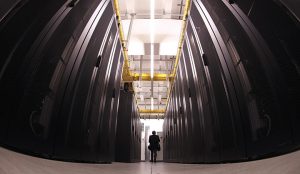Bloomberg
Germany wants to force its power-hungry data centers to harness excess heat for warming residential homes — an effort which the industry warns is likely to fall flat.
The country has become one of the largest global hubs for data centers thanks to its clear data protection and security laws. Politicians are now trying to re-purpose some of their controversial excess heat to improve efficiency in light of the energy crisis.
While in theory an innovative way to reduce the industry’s immense carbon footprint, experts have pointed to a flaw in the government’s proposal expected to be passed this month: potential recipients of waste heat are not being compelled to take it.
The warm air expelled by server farms isn’t nearly as hot as that required by most district heating networks. That means any utility they partner with must invest in heat pumps to bring the air to usable levels, further ramping up costs and power usage.
“Data center operators are mostly ready and willing to give away their waste heat,†according to Ralph Hintemann, senior researcher at the data center lobby group Borderstep. “The challenge here is finding someone who can use that heat economically.â€
What’s at stake for Europe’s largest economy is that it either risks scaring off IT investments and slowing its efforts to digitize, or falling behind on climate goals. The energy efficiency law being prepared by the government aims to save some 500 terawatt-hours of energy by 2030 — pegged in part on a requirement to reuse at least 30% of a new data center’s heat by 2025. A spokesperson for Germany’s Economy Ministry said the new draft will contain “significantly less bureaucracy†once it has been completed.
One project in the country’s financial hub Frankfurt demonstrates that while niche cases can work, it will be challenging to reach those goals.
The “Westville†residential quarter is due to complete construction by mid-2025. Its 1,300 apartments will be heated in large part by warmth from a nearby server farm, saving carbon emissions equivalent to about 200 combustion-engine cars per year. But the regional energy provider participating in the collaboration — Mainova AG — said that proximity played a key role in the project. The new development is located only 500 meters away from the data center operated by Telehouse Deutschland GmbH.
 The Gulf Time Newspaper One of the finest business newspapers in the UAE brought to you by our professional writers and editors.
The Gulf Time Newspaper One of the finest business newspapers in the UAE brought to you by our professional writers and editors.
